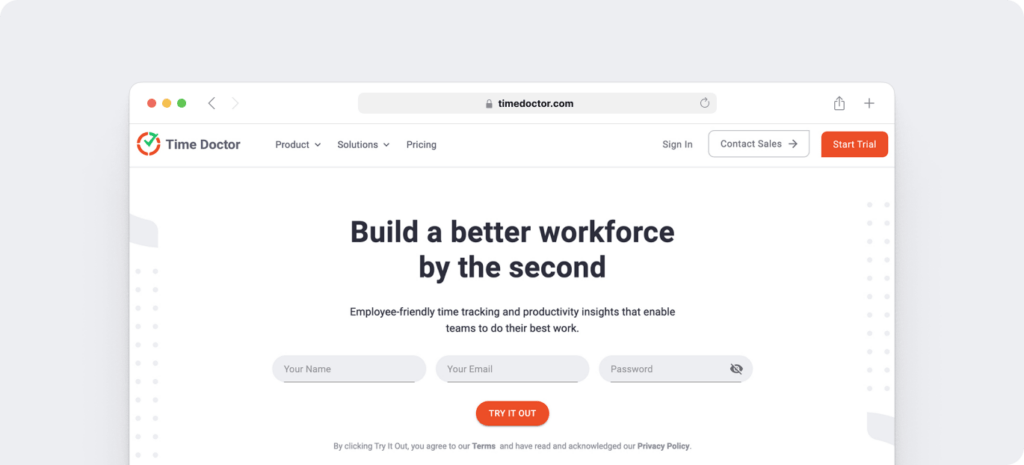The future of work is here, and many businesses are now adopting new ways of working.
Why?
We have moved on from the industrial age to the age of technology. The new generation of employees prefers a digital workplace that uses advanced technology and allows them a certain degree of autonomy.
Additionally, the Covid 19 pandemic has made it even more critical for companies to adopt new working systems that help them survive and grow in an ever-changing business environment.
In this article, we’ll talk about the new ways of working and discuss its benefits. We’ll also look at the major technologies you need in this new world of work.
This article contains:
(Click on a link below to jump to that section)
- What are the New Ways of Working?
- 5 Technologies to Integrate New Ways of Working
- 4 Game-changing Benefits of New Ways of Working
- 3 Ways to Implement New Ways of Working
Let’s dive in.
What are the new ways of working?
The phrase “new work” was coined by a German-Austrian professor – Frithjof Bergmann, back in the 1980s. He wanted to change the very foundation of work to offer people greater freedom and work engagement.
‘New ways of working’ was a radical departure from the office-bound corporate culture of the early 20th century.
It started with concepts like mobile offices, flexible workspaces, videoconferencing, etc with the aim to reduce people’s burdens by using digitization for automating work processes.
Along the same lines, today’s new ways of working intend to enhance employee experience and employee retention in the workplace by bringing about changes in:
- Time: Employees need not work 9-5 or in set shifts. The focus is on the outcome and meeting the deadlines, irrespective of when they work.
- Place: Employees don’t need to be present in a physical office space to complete their work.
- Contracts: People no longer need to be bound by full-time contracts. They get paid for the outputs, products, or services they provide.
Some popular work environments that follow these new ways of working include:
- Freelancing: Self-employed people offer their services to companies and often work for multiple clients at the same time.
- Flextime: Employees work a set number of hours but are free to choose the start and stop times.
- Job sharing: Two or more people are employed on a part-time or reduced-time basis to complete a job normally done by one full-time employee.
- Telecommuting: The staff prefers remote working using modern technological tools for collaboration like Slack, Zoom, etc.
These flexible working environments replace the barriers and styles of the past era with a work culture that focuses on the empowerment of the modern multigenerational workforce.
5 technologies to integrate new ways of working
Using some advanced technologies can greatly simplify the transition to a flexible office space.
Let’s look at the top 5 ones:
1. Design thinking
Design thinking involves using a set of practical, strategic, and cognitive processes to find solutions. You can apply it to any field or industry, including developing creative business strategies.
Organizations are increasingly using this methodology to identify the right solutions for their customers and build better products.
Here are the five stages of the design thinking model:
- Empathize: Incorporate empathy to understand and prioritize the customer.
- Define: Clearly define the user’s problems, needs, and record insights.
- Ideate: Generate multiple ideas for solving the problem.
- Prototype: Create working models and representations of the best ideas.
- Test: Try out the new concept to integrate into the business and refine it as per feedback.
Design thinking aims to understand the user’s needs to create useful innovations that address old and new challenges. It also helps you look for the right questions to address during the process.
2. Artificial Intelligence
Artificial Intelligence (AI) can drastically change the way you make project management decisions. It can help eliminate errors and biases while creating budgets, developing schedules, etc.
AI-based tools can save time and allow a team leader to focus on areas that require a human touch, such as team building and personal development.
These tools can also use other components of AI, like deep learning, to ensure that the projects stay aligned with the business goals and the organizational needs.
Customer support teams also use AI to collect customer data from various channels and provide a customized experience, enhancing customer satisfaction.
3. Cognitive computing
Cognitive computing is a part of AI and uses technologies, such as machine learning to analyze large data sets, make predictions, and promote business discoveries.
Tools with cognitive computing can learn through experience or human instructions, converse in a natural language, weigh in evidence to offer the best possible results, etc.
Cognitive computing also has other applications like:
- Finance: Analyze the market and make valuable suggestions for investments.
- Healthcare: Access past patient records and answer treatment-related questions.
- Travel: Aggregate information like pricing and flight availability to offer customized suggestions.
4. Organizational agility
An agile organization moves quickly, effectively, and decisively to embrace change while also staying in touch with the customers’ needs.
Organizational agility allows you to anticipate, initiate, and take advantage of any change and also remain flexible enough to accommodate setbacks.
For example, while setting up a new coffee shop, you should be able to anticipate the needs of your customers and design the menu accordingly. However, you must also be flexible enough to modify this menu if it doesn’t get a great response.
Increasing the agility of your organization needs an actively engaged workforce. That’s why you should handhold your employees through a smooth transition to the new approaches from the old ones.
5. DevOps
DevOps (development + operations) is a delivery approach that involves collaborating with all the teams in the product life cycle — design, development, and deployment.
The process ensures that all operations are synchronized and that the final product is practical, can be repaired quickly in case of issues, and is deployed faster.
It emphasizes quality, testing, automation, and collaboration to reduce the production and deployment times.
Similar to the agile way of working, DevOps helps businesses deliver rapid and reliable products, services, and customer experiences in the ever-changing business environment.
This kind of digital transformation has dramatically improved the way many businesses work, allowing them to focus more on their employee experience and customer satisfaction.

4 game-changing benefits of new ways of working
Satisfied and engaged employees can deliver better customer experiences and satisfaction.
Using new technology and adopting the new way of working can enhance employee engagement.
Here’s how:
1. Varied work agreements
In new ways of working, the employer doesn’t need to offer full-time jobs or related benefits to get their work done.
They can simply hire people who’ll complete a particular task, rather than compelling them to become ‘employees’. In turn, they don’t need to worry about high costs, human resource management, or the legal aspects of hiring a full-time employee.
Flexible working arrangements, like freelancing, are beneficial for employees as well.
Many professionals find that they have a better work engagement as they can control their own time and widen their work horizons.
This type of portfolio worker has several part-time employment contracts that allow them to work with multiple clients and enhance their skills.
Professionals no longer need to restrict the scope of their success to a full-time job with one employer for years.
2. Promotes a culture of equality
Older working practices involved hierarchical structures where all the power rested with the top management, who delegated work activities through the layers of management.
Leaders believed in knowledge hoarding as means of showing their authority. People who complied with the existing culture were praised, while those who opposed it were written off.
However, the new ways of working are changing these old work cultures. The new generation of digital natives in the working population emphasizes creating a culture of equality.
These professionals believe in knowledge sharing for better end results.
They want to know why they should do a task in a certain way or why knowledge work depends on a fixed place and time. They also believe in focusing on their core skills and using technology to complete routine work.
3. Allows greater flexibility of work
Historically, work involved passing down physical documents or objects to another person. That’s why fixed workstations and fixed work hours were necessary.
However, technology allows greater flexibility of work.
In-house and virtual teams can collaborate with colleagues from home or on the go. They can also carry their computers and files wherever they are and share files virtually with anyone, anywhere.
Additionally, the new generation workforce has different priorities.
While money and financial stability are still important, they don’t like to revolve their life around work. For them, social interaction with friends, vacations, social media activities, family commitments, etc., are equally important.
Due to this change in mindset, they are challenging the old management practices of fixed working hours and places.
4. Prioritizes work-life balance
The previous generation of employees prioritized getting a good paycheck in order to have a decent standard of living. They were even willing to sacrifice their personal and social life at times to reach top positions.
However, as the focus on mental health at the workplace increases, so does the need for employees to maintain a good work-life balance.
New generation employees are even willing to switch jobs to achieve this balance. They prefer jobs that offer them career progress without sacrificing their personal life.
Here’s why you must encourage work-life balance in remote work environments.
3 ways to implement new ways of working
Shifting from a traditional setup to a flexible work environment is a radical change for any company. Older employees and those who’re used to the conventional working practices can find it harder to adjust to the new ways.
Companies must strike a balance between attracting new talent and retaining the loyalty of existing employees.
Here are three smart ways to change your working environment and help everyone adopt it:
1. Install a change management process
People have set habits, beliefs, and behaviors about how they work and how others should too. In order to successfully implement a flexible work environment, they need to adapt to the changing culture.
Change management can help you achieve this goal.
It refers to the actions you take to change a significant aspect of your business.
You can follow these five steps:
- Prepare the organization.
- Create a plan for change.
- Implement the changes.
- Embed changes into the company culture.
- Analyze the success or failure of the change.
A critical aspect of this effort is encouraging your staff to connect with their work and find their own sustainable ways to adapt to the work changes.
You shouldn’t restrict the change process to just your staff. It should also extend to your client/customer interactions.
The change process should involve using virtual tools for gathering data, providing personalized solutions, conducting team meetings involving the client, etc.
2. Focus on employee well-being
A work environment that offers greater flexibility may often include remote work.
But employees who are used to working in a traditional setup with their colleagues sitting just a desk away may find this isolating and monotonous.
That’s why it’s essential to focus on frequent virtual meetings and creating a safe environment where they’ll feel supported, especially regarding their mental wellness.
Ensure that you foster the right workplace relationships and upgrade your infrastructure to efficiently support any such flexibility of your workforce.
In addition, you should consider your health and safety policies and update them to accommodate the new ways of working.
3. Use productivity management software
People in leadership roles may think that only a traditional workplace can foster productivity.
However, the tools and technologies used in the new ways of working include productivity software that can encourage people to be more efficient.
A simple yet highly effective tool that can do this for you is Time Doctor.
What is Time Doctor?

Time Doctor is a robust employee time tracking and performance management tool used by major companies, like Ericsson, as well as by small businesses, like Thrive Market, to boost team productivity.
Here’s how the tool can redefine the way you implement new ways of working:
- Enhances employee productivity by tracking time spent on different projects and tasks.
- Allows you to schedule shifts to avoid confusion about the work hours.
- Lets you monitor the attendance of remote workers to understand the staffing requirements.
- Generates multiple comprehensive reports in real-time for taking data-backed decisions.
- Enables you to pay the staff directly via Paypal, Wise, etc., in any currency and for any pay period.
Final thoughts
Organizations worldwide have started implementing new ways of working, more so after the onset of the pandemic. And to stay ahead of your competition, you should too!
It’ll help boost metrics like customer engagement and satisfaction, as well as employee retention.
This article will be a good start to familiarize yourself with the technologies that form the core of flexible work environments. You can also use these above tips to implement this new work environment with ease.

Andy is a technology & marketing leader who has delivered award-winning and world-first experiences.


